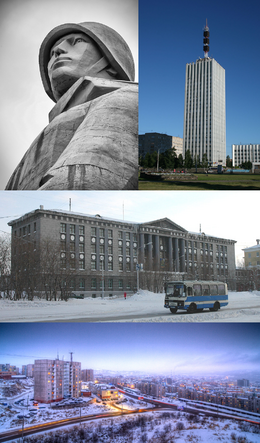Nizhnebersutsk
This article is incomplete because it is pending further input from participants, or it is a work-in-progress by one author. Please comment on this article's talk page to share your input, comments and questions. Note: To contribute to this article, you may need to seek help from the author(s) of this page. |
Nizhnebersutsk
Ніжнеберсутськ | |
|---|---|
 Clockwise from top: Tomb of the Unknown Soldier Monument, Yelan Commercial Tower, Nizhnebersutsk City Council Building, central Nizhnebersutsk at the intersection of DZ-1 and Luginska Street | |
| Etymology: "Lower Bersut city" | |
| Country | |
| Territory | |
| Founded | 1693 (as Casimirsk) |
| City status | 1909 |
| Districts | Kozminsk Lozovoy Tsentralnyy Zenkino |
| Government | |
| • Body | Nizhnebersutsk City Council |
| • Mayor | Konstantin Shcherba (PF) |
| Area | |
| • Total | 186.7 km2 (72.1 sq mi) |
| Elevation | 0–29 m (0–95 ft) |
| Population | |
| • Total | 108,817 (−3.0%) |
| • Census | 112,162 |
| Time zone | UTC-10 |
| Area codes | for multiple area codes |
Nizhnebersutsk (Soravian: Ніжнеберсутськ, IPA: [nʲɪʒnʲɪ'berʲsutsʲk]), also informally known as just Bersutsk is the capital and largest city of the territory of George Ruset Land, an overseas dependency of the Soravian Republic. It also serves as the economic, cultural, and political centre of the region, as well as an industrial centre for copper mining and local naval industry. Its population as of 2017 was 112,162, and has been in constant decline since the 1980s. It is the world's northernmost city above 100,000 residents as well as the world's northernment permanently inhabited city.
Nizhnebersutsk was first settled in the late 17th century as Casimirsk, named for Casimir I, who was Soravian Emperor at the time. With the development and settlement of Soravian colonies in Chistovodia and Vinalia, Casimirsk remained a minor, isolated fishing village, and its population rarely exceeded 1,000. After the First Soravian Civil War and the loss of Soravia's overseas colonies, Casimirsk had a renewed importance for the maintenance of a Soravian fleet in Asteria Superior. Small naval squadrons were stationed in the city, renamed to Nizhnebersutsk in 1880, but the settlement continued to remain relatively minor. When vast copper reserves were discovered near the city in 1900, the city experienced a large migration boom as miners and their families relocated to the city to work.
Nizhnebersutsk was granted city status in 1909, and its population rapidly grew in the early 20th century. Records show a population rise from 7,119 in 1900 to 41,904 in the first recorded nationwide census in 1937. The Great War stagnated the export of copper from the city's mines as ships in the Lumine were susceptible to enemy interception. After the Solarian War, it continued to attract migrants with the prospect of work, especially with the post-war employment slump that had resulted from the war. The population of the city reached 100,000 in 1963. Since the fall of the UPSR, the city has become increasingly dilapidated with its residents relocating back to the mainland.
Lack of opportunity as well as ineffective local governance are amongst the reasons why Nizhnebersutsk's population has been in decline since the 1980s. Air pollution such as smog from nearby mines is common in the city. Many buildings in the city have been abandoned and it is generally considered to be poorly maintained. In more recent times, disaster tourism has become popular in the city due to its uncharacteristic size. Aeronovo conducts twice-monthly flights to the city from Samistopol, which are the only way to travel to and from the city elsewhere.

